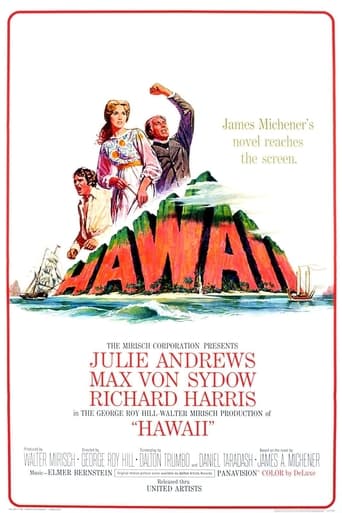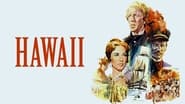JasparLamarCrabb
An epic that is largely character driven and that actually works to its detriment. Minister Max von Sydow and his New Englander wife Julie Andrews head for mission work in Hawaii and face storms at sea, fires, disease and some very sexually free natives. Director George Roy Hill assembles a staid adaption of the James A. Michener novel and though the production values are all first rate, the script stagnates to the point of being sleep inducing when it should be sweeping. The acting is good, though there is probably one too many scenes of von Sydow in full on fire & brimstone mode. He's really annoying. Andrews is very restrained, so much so that it's difficult to believe she would have stayed with such a block headed husband. Richard Harris, Gene Hackman and George Rose are in it too. Jocelyne LaGarde, an Oscar nominee for her only film appearance, steals a number of scenes as the very bossy Malama Kanakoa.
oceanchick
I watched Hawaii to see Max Von Sydow. I was surprised to see that he seemed as miscast in Hawaii as Gregory Peck was in Moby Dick.Yet it seems an absurdity to have a 'miscast', because a good actor should be able to play any part. I guess it wasn't truly a 'miscast' but more of a 'why the heck did Sydow take that part?!".Sydow's pedigree is beyond the scripted Abner Hale. The part of Hale was shallow in its overbearing nature, lazy in its development, basely barking unrealistic condemnations, and lacking any human substance---and in effect, overplayed. Sydow had fewer than 10 "human" lines in the entire film, leaving viewers to listen to elementary prattle. Abner Hale had the potential to be a very powerful character. The writers simply failed to provide dialog with depth.Comparing Hawaii to Capote where the viewer is allowed to freely dislike Truman Capote because of his nature, the words spoken by Hoffman were believable giving depth to his character and grounds for the viewer's emotion. That depth was never achieved in Hawaii, offering instead preposterously hollow, ridiculously vacant lines. Directing Sydow to play Hale in an exaggerated fashion only made it worse. His religious fanaticism was not buy-able; he appeared more of a lunatic.Having seen Sydow's acting in numerous works, he has proved capable should he be given something to work with. But the script is dull, reads like a dime-store children's novel, and in effect lent nothing to play.Julie Andrews stayed in the shadows the entire film, suggesting that was also her role in the church/relationship, but she was the only character that had any depth. Her lines were few but solid and she had a believable countenance.The Hawaiian characters were written stereotypically, speaking w/ broken English but apparently understanding all of Hale's embellished sophisticated condemnations. The Queen seemed jovial and bossy; she was the most natural of the Hawaiians on camera, earning LaGarde the only acting award for the movie. The rest of the Hawaiian actors (both speaking and extras) seemed stiff and comparably makes Keanu Reeves look like a Larry Olivier.I can appreciate the attempts to keep the natives natural (and by default, topless) but because the movie lacked substance not provided by the script, the semi-nude natives are reduced to gratuitous fodder. It's as if the producers knew the movie was a stink-bomb and put a lot of breasts on camera to distract the viewer from the stench. The cinematography of Hawaii was very basic and this movie was one of the last of Russell Harlan's career. Though the movie is credited as being filmed in Hawaii, most often the scenes looked like they were shot on sets. Interior ship scenes were done cleverly and the editing was tight. The musical score was sterling. Though I have enjoyed George Hill's later directorial efforts, I believe that problems with the script and loss of the original director resulting from such problems left Hill with less to work with than what he should have had. Comparably, Val Lewton's films often have better screenplays and believable characters, tighter shooting schedules, lack of lush locations, and they are done on inconceivably low budgets.As for the religious theme and the resulting troubles the Hawaiians ensued as a result, the theme is interesting and worthy of exploration. I do understand the nature of the missionaries giving up their lives and going away possibly never to see their families again, as my father was a minister. I understand the fanaticism implied by Hale's character, as well as his close-mindedness to the concept of God being not only a vengeful God but also one of love, patience and understanding. But my understanding of the concepts of the movie do not excuse the fact that it was very poorly written.I, for one, do not believe that I should have to read the book to make allowances for a poorly made movie. The movie should be strong enough to stand on its own. It isn't necessary for one to read Gone With The Wind to understand why Scarlett will never go hungry again, nor any of her folk.
bkoganbing
From the day Captain Cook arrived on those beautiful islands, Hawaii like Poland was cursed because of geography. Poland situated between two gigantic European powers just became a pawn in the eternal military and diplomatic chess game.Hawaii located where it is between North America and the Orient, when sea travel improved it was only a matter of time before the big powers came a-callin'. And they came from both directions. Not shown in the time frame this film covers, but soon after, waves of Japanese and Chinese immigrants landed on the shore. Hawaii was coveted by all and America got it.Max Von Sydow plays a young New England minister out to bring the gospel to the heathen as he sees them and has been taught to see them. His church won't send him out to the south seas without a wife, lest he be tempted by sins of the flesh, so on a short acquaintance he marries Julie Andrews. She in turn has been home pining away for whaling captain Richard Harris. When Von Sydow and Andrews get to Hawaii over the course of their story Harris would reappear.Naturally its quite a culture shock for the New Englanders when they get to Hawaii. The film's story covers about a quarter of a century of Hawaiian history and the history of the changing attitudes of Andrews and Von Sydow. James Michener's original novel was of War and Peace duration and I suppose the final script was as best they could get it and cover what he was trying to convey. Despite the obvious racist feelings that Von Sydow has, he's a basically decent man who does do some positive good.His problem is that everything with him has to be filtered through the Bible. There's a lot of incest going on in Hawaii when he lands there. Reason being is that these are islands with a limited number of mating partners. Now incest is bad as we know because it does eventually weaken the gene pool. But Von Sydow hardly takes a scientific approach, how could he, he doesn't know it, he hasn't been taught it.Julie Andrews is a far cry from the perky Mary Poppins. She develops quite an attachment to Hawaii and its people and her approach with them is fundamentally different than her husband's. It's not a bad performance.Richard Harris is the lusty whaling captain of Andrews previous affections. I tend to think his part might have been edited down. In a recent biography of Harris, it was stated he and Andrews did not get along at all on the set. Harris in those days was a whole lot like the characters he played like this one in Hawaii.Of course when you've got Hawaii as a subject for a camera, the photography could not be anything but gorgeous.Hawaii covers a period not well known to most Americans except Hawaiians. And indeed they are Americans and have been since 1959. I think people could learn something from this film even with the script flaws.
readinglips
The film begins in 1819. When we first hear about Jerusha (Julie Andrews), she is a "Christian girl of 22." Later, her tombstone (the spoiler in this message) reads: "1799 - 1834". Do the math: she must have been 19 or 20 in 1819.This film is an amazing hodgepodge of sometimes good writing and often bad acting. The pre-credit sequence, a narration of how people first came to Hawaii 800 or so years ("30 generations") before, is quite poetic and visually stunning. But much of the acting is stiff and passion-less. (Do look for Carroll O'Connor -– very good in a small part at the beginning as Jerusha's father.) The film uses one fascinating (and very effective) device: some scenes end with the first few lines of dialog of the next scene coming up "early", as a way of propelling the film forward. Considering how avant garde this is, it's surprising this has not been used in any other mainstream films -- at least none that I know of. (I recently purchased the DVD because I was interested in seeing the film with captions (CC). It is missing about 15-20 minutes, most of it from the ocean voyage towards the beginning of the film. No special features to speak of.)


